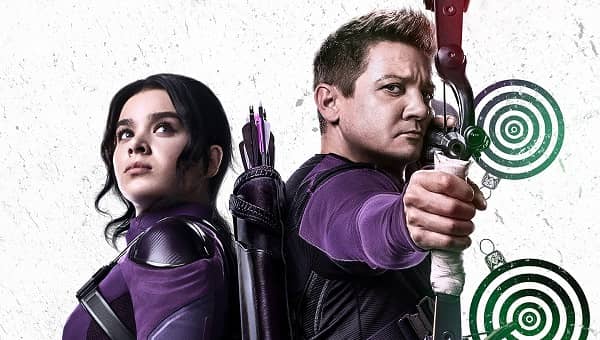Hawkeye, the latest entry in the Marvel Cinematic Universe’s foray into small-screen programming, differs from its predecessors in a number of ways, most notably in tone and stakes. So far, the MCU’s Disney+ trips have wowed with their high-stakes storytelling.
Wandavision contains a large meta-narrative about the protagonist’s journey through the five stages of sorrow. The theatrical elements of The Falcon and the Winter Soldier were just a ruse to allow the show to delve into real-world issues like race relations and PTSD. And Loki, the god of mischief, fought the great powers of light and dark, predicting the end of the world as we know it.
Given that backdrop, Hawkeye is a refreshing change of pace, as the stakes aren’t as high as the end of the world, but rather whether Clint Barton (Jeremy Renner) will make it home for Christmas.
Despite being named after the main Avenger, Hawkeye’s first episodes focus on Barton’s successor, the volatile Kate Bishop, played with aplomb by Hailee Steinfeld.
The concept fits with the show’s low-key ethos: Barton is on vacation in New York with his kids, while Bishop is involved in some less-than-savory illegal activities. Their paths naturally cross, and hilarity ensues.
The Plucky Protégé and the Grumpy Archer
Hawkeye’s light-on-his-feet story, combined with the Christmas setting, makes for a particularly delightful and entertaining MCU outing, fueled by the buddy-cop interaction between Barton and Bishops.
Renner, who has been playing second fiddle to Barton for eleven years, adds additional wrinkles to his world-weary countenance. Renner has been relegated to becoming just another cog in the machine in the larger, ensemble-driven blockbusters, but thanks to the deft character work possibilities afforded by the format, he is firing on all cylinders here.
His Barton is a damaged guy who is full of regret. He is plagued by remorse and wishes to forget the horrors of his past, but he lives in a world that will not allow him to do so.

The feisty Bishop, on the other hand, is endowed with wide-eyed fervor and a shoot-first-think-later approach. That yin-yang interplay is at the heart of what makes Hawkeye’s first few episodes so compelling to watch. The on-screen chemistry between Renner and Steinfeld is palpable. Their characters form an unexpected pairing, which the show emphasizes. Hawkeye is at its best when its two main characters are on screen together, bouncing ideas off each other and exchanging one-liners.
With a dash of pathos
But it isn’t all fun and games. We see the toll that being a superhero has had on Barton as the show sheds insight on his inner workings. The characters’ partial hearing loss serves as a stark reminder that Barton is one of the two human Avengers—he lacks superpowers or a high-tech suit, and he fights forces far beyond his comprehension with a bow and arrow. This has ramifications.
Barton is still reeling from the events of Avengers: Endgame, lamenting the loss of Black Widow and wrestling with his guilt over his time as the assassin Ronin. While the program isn’t overly serious, it does have a few moments of heartbreaking sorrow involving Renner’s Barton. It’s a testament to its qualities that it accomplishes this without becoming overbearing.
View this post on Instagram
Hawkeye is primarily about two things: Kate Bishop’s coming out celebration and Clint Barton’s inevitable farewell. Both aspects have been properly covered in the first two episodes, if the first two episodes are any indicator. As the play progresses, the grumpy and hesitant mentor may transfer the baton (or, in this case, the quiver) to his ecstatic protege.
Hawkeye has shown us what it takes to keep going—fun, bubbly, full of emotion, and with very modest risks. While the program hasn’t quite hit the target yet, it’s not far off.
Also Read: Angel Adoree, Ava Michelle C ota, Kaitlin Sharkey, Melanie Olmstead
